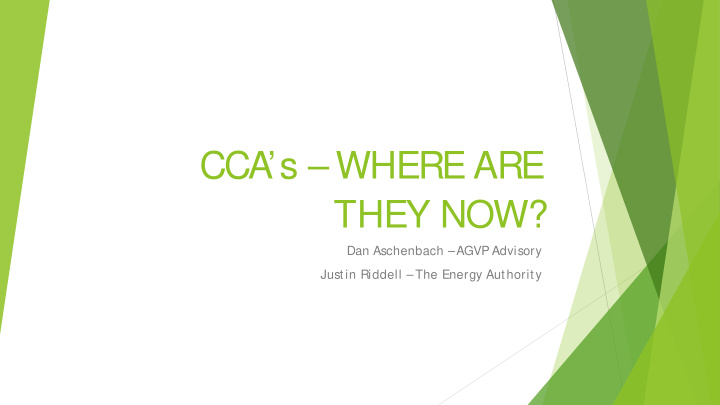



CCA ’s – WHERE ARE THEY NOW? Dan Aschenbach –AGVP Advisory Justin Riddell –The Energy Authority
Introduction Created to provide choice in energy California Physical Power Mission: S ustainable energy initiatives Vision: Energy conservation and efficiency; Locally-sourced energy needs Types of CCAs Joint Powers Authority S ingle Jurisdiction Commercial Vendor Package
CCAs and IOUs S ource: ht t ps:/ / cal-cca.org/ cca-impact / S ource: ht t ps:/ / ww2.energy.ca.gov/ maps/ serviceareas/ elect ric_service_areas.ht ml
CCAs and IOUs CCA IOU S ecure bulk power Billing & Collection S ource locally Transmission Rate-setting authority Distribution Opt-Out Opt-Up
Qualitative Considerations CCAs are self-regulated and have local control on power resource planning after CPUC approves initial plan Rate-setting authority is responsibility of CCA governing board Territory that the CCA is serving
Opt-Out-Different from IOU and Municipal Electric Utilities Customers in service area of IOU are automatically CCA customers once CCA governing board approves program. But CCA customer can opt-out and go back to IOU CCA can charge an exit fee which could compensate CCA for any costs incurred on customer’s behalf-no experience thus far on implementing fee
CCA Rate S etting Examples and % of Renewable Energy CCA Base Choice 100% Solar Rate NEM AVCCE 35% 50% 100% 100% CPS F 39% 48% 100% CP A 36% 50% 100% MCE 60% 100% 100% PRIME 50% 100% 100% RMEA 50% 100% 100% S JCE 45% 100% 100% S VCE 50% 100% S EA 50% 100% 100%
CCA Credit Risks & Mitigations S tart-up funding Inherently the largest risk is during the start-up phase Invoicing and Payment schedule IOU Payments PG&E Bankruptcy Judge ruled that funds do not belong to the IOU (PG&E), must flow to CCA Implicit vs Explicit support Linkage to county/ city Lockbox
S trengths Strengths Comment Rate-setting autonomy Local control and flexibility Focus on popular renewable energy Targeted service provides and efficiency programs reputational strength Few legacy out -of-the-money Thus far discount to maj or IOUs contracts Accepted role and continued Competitiveness evidence of legislative support Broad political support from city mayors to legislators and statutory basis for CCA role
Risks Comment Risks Opt-out risk Uncertainty about future cost recovery Market risk Long-term fixed power supply vs. adequacy of cost recovery Competitiveness Relates to opt-out risk Pressure to keep rates lower than IOU S ection 6.2 untested Judge ruling on CCA revenues are JP A withdrawal CCA revenues PGE bankruptcy
Power Cost Indifference Adj ustment (PCIA) A charge in the rate-setting Exit-fee to all IOU customers. structure that is meant to leave the IOU whole. Represents the cost the IOU bears for power that was already Determined by the California PUC. purchased for load prior to CCA establishment. CCAs do not have the ability to alter this PCIA charge to customers.
Lockbox General Design S trengths and Concerns Accounts Receivables from Form of collateral, especially ratepayers, collected through the during start-up phase. IOU, are routed through the Gives S upplier first right lockbox. S uppliers have access to the lockbox and first right of withdraw. How many S uppliers are in the S uppliers have the right to future lockbox? cash flows through the lockbox in the event of default. S hortfalls: Can take time to get full reimbursement. Customizable.
Current Ratings Moody’s Methodology: US Municipal Joint Action Agencies Credit Quality & Cost Recovery Framework Resource Risk Management Competitiveness Financial S trength & Liquidity Willingness to Recover Costs Marin Clean Energy: Baa2/ S table; Fitch-BBB/ S table Peninsula Clean Energy Authority: Baa2/ S table
Financial S tatement Considerations Little to no long-term debt Cash Balances Indicative of the county and maturity Positive Net Income Look at the unrestricted cash Cash Provided By (Used in) Little to no CAPEX. Operations Larger established CCAs have sizable Cash Provided by Operations. S maller CCAs are much lower and even negative (used in).
Expansion on the horizon… Monterey Bay Community Power expansion to include eleven cities. Largest, geographically speaking, of all CCAs in California. Marin Clean Energy added Contra Costa County in 2019. S olano County will be added on April 1, 2020. Desert Community Energy starts April 1, 2020. Palm S prings, Cathedral City, and Palm Desert. Western Community Energy starts S pring 2020. Norco, Perris, and Wildomar launch April 2020. Jurupa Valley, Hemet, and Eastvale will launch in May 2020.
Changes on the horizon… Offsetting the effects of PG&E’s Public S afety Power S hutoffs Infrastructure S onoma Clean Power plans to begin exploring the possibility of taking over all or some of PG&E's infrastructure for the Northern California counties Valley Clean Energy board made a $300 million offer for PG&E’s assets Microgrids CPUC Rulemaking RA Requirements Grants available from the S tate Battery S torage 32.7 megawatts of battery energy storage devices
Milestones The CCAs in Nov. 2019 passed 3,000 MW of contracted renewable energy. 10,000 MW of renewable energy contracts are planned by 2030.
Recommend
More recommend